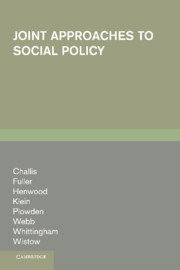Book contents
- Frontmatter
- Contents
- Biographical notes
- Preface
- Acknowledgements
- 1 Rationality – the history of an idea
- 2 Investigating policy coordination: issues and hypotheses
- 3 Policy coordination for children under five and for elderly people
- 4 Whatever happened to JASP?
- 5 Policy coordination: a view of Whitehall
- 6 Coordination at local level: introducing methods and localities
- 7 Coordination at local level: state of play
- 8 Barriers and opportunities
- 9 Costs, benefits and incentives
- 10 Understanding coordination
- 11 Towards a new model of social planning
- Index
4 - Whatever happened to JASP?
Published online by Cambridge University Press: 06 July 2010
- Frontmatter
- Contents
- Biographical notes
- Preface
- Acknowledgements
- 1 Rationality – the history of an idea
- 2 Investigating policy coordination: issues and hypotheses
- 3 Policy coordination for children under five and for elderly people
- 4 Whatever happened to JASP?
- 5 Policy coordination: a view of Whitehall
- 6 Coordination at local level: introducing methods and localities
- 7 Coordination at local level: state of play
- 8 Barriers and opportunities
- 9 Costs, benefits and incentives
- 10 Understanding coordination
- 11 Towards a new model of social planning
- Index
Summary
The attempts made within central government between 1971 and 1978 to improve the coordination of social policies can legitimately be regarded as probably the most sustained single attempt to apply the ‘optimistic’ model. In fact, the attempt comprised several different episodes, with an almost cyclical fluctuation in the balance between the ‘optimistic’ and what might be called the ‘pragmatic’ elements in the approach – culminating in an acceptance so total of the ‘pessimistic’ approach that the role of the centre diminished to complete inaction.
Although the notion of a centrally-steered ‘joint approach’ is inseparable from the existence and purposes of the CPRS, JASP had two immediate predecessors. The first disappeared without progeny; the second could be regarded, if not as a parent, at least as a godparent of JASP.
The first sustained attempts at coordination in the ‘social’ or welfare field began in 1967 when Michael Stewart took over from Douglas Houghton both the chairmanship of the Cabinet's Social Services Committee and an extremely ill-defined task as social services coordinator. He acquired as an official ‘adviser’ a civil servant from the Ministry of Education, Paul Odgers. Stewart and Odgers, working through the Social Services Committee (and its supporting committee of civil servants), started to explore the problems and possibilities. They took their brief to cover social security, health, probation, rent rebates and sheltered housing, and aspects of education such as school meals.
- Type
- Chapter
- Information
- Joint Approaches to Social PolicyRationality and Practice, pp. 71 - 105Publisher: Cambridge University PressPrint publication year: 1988



